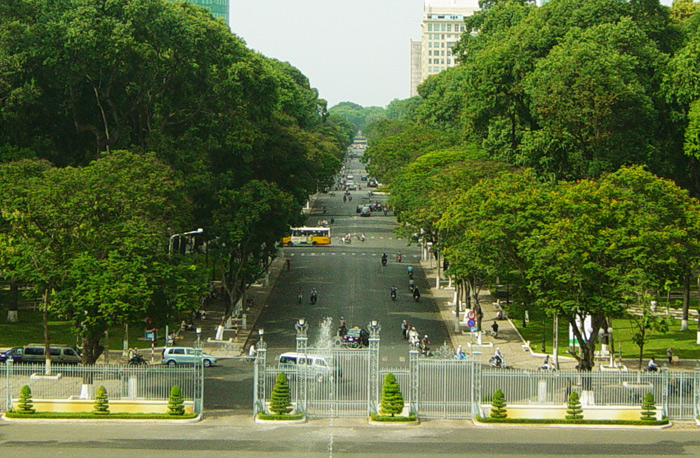With green space losing out to several large public infrastructure projects, local residents are worried about the future of Ho Chi Minh City’s urban environment. Michael Tatarski looks into one group’s conservation efforts and asks whether the city can develop without giving in to environmental tradeoffs.
When news broke in November that the city would clear 84 mahogany trees from Ton Duc Thang Street to make way for construction of another bridge from District 1 to the Thu Thiem area across the Saigon River in District 2, Nguyen Phuong Thao felt she could no longer stand by. “Someone needed to speak up, and I decided I would be the first to do it,” she says through a translator.
The announcement came on the heels of another story that 200 trees would also be felled in District 2, while part of Le Loi and all of Nguyen Hue, two major downtown thoroughfares, had already been denuded for work on a pedestrian boulevard and the metro system. According to Thao, who owns a coffee shop and works for a company that builds brands, many residents felt depressed by the news because they couldn’t do anything, as the plans were already approved when they were released to the public. In response she created a website, HappyTreeInSaigon.com, to give voice to those concerned by the removal of so much green space.
“The purpose of the website was to collect signatures and send them to the agencies and organisations [in charge of the bridge and other projects] so the government will know about the expectations of the citizens and consider more carefully before they conduct something that may harm the environment,” Thao says.
So far, Thao and her team have collected around 3,000 signatures, about half of which are from students. “The final purpose is to get the attention of people who have authority because I don’t want to do this alone,” she says. “I want someone who actually has power and can make an impact.”
Happy Tree in Saigon, the group born from the website, made headlines late last year when members gathered on Ton Duc Thang and held banners explaining the importance of the doomed trees. However, the group does not plan any repeat actions, since the police were concerned about traffic jams related to the group’s presence. “We will focus more on digital media and when we have enough funds we will focus on one spot, like having an event in one place, not on the street,” Thao stresses.
When it comes to funding, Thao is hopeful that NGOs working on environmental projects in Saigon will be willing to provide monetary support to her conservation efforts. If money comes through, Thao aims to create an education campaign centred on the environment. “Youths do not fully understand the environment … I want them to learn how to protect it in the correct way,” she explains.
Dr Michael Waibel, a professor in the Department of Human Geography at the University of Hamburg who has studied Vietnam since 1996, agrees that Saigon has a green space problem. According to statistics from the HCMC Park and Greenery Office, the city has just 0.8 square metres of green space per capita. This puts the city well below the World Health Organisation’s recommendation of a minimum eight square metres per capita. However, Waibel’s main concern is inequality in access to green space. “People in District 7 or on the outskirts have much better access,” he says. “The biggest problem is with the densely-populated inner city. It’s a socioeconomic question.”
He views the current situation with the trees in a more utilitarian way. “Regarding the trees on Le Loi, in this case it’s a tradeoff. You need a public transportation system to decrease individual traffic, so you make something that is good for sustainability but you have to cut the trees,” Waibel says from Hamburg. He is also positive about the future of green space in the city, something which may hearten Thao and the other members of Happy Tree in Saigon.
“One thing you can say is that the trees grow incredibly fast in Saigon,” the urban planner says. “Look at Phu My Hung [a new urban area south of the city], where the trees have become huge in just ten years.” If trees are replanted once the projects are completed, he reckons, the streets could look nearly normal in just a decade or two. The city government has also set a target of raising the provision of green space to four or five square metres per capita in the future.
However, these initiatives can’t come solely from authorities. “The people themselves have to realize and fight for more green space in their neighbourhoods,” Waibel says. He points to the verdant hems, or alleys, of the city, often full of potted plants and flowers. “This kind of bottom-up initiative to expand green space should be supported and people should be educated that they have their own responsibility,” he continues.
Thao understands this responsibility and hopes Happy Tree in Saigon can link decision-makers and the general public. “What we are perceiving wrong is that we develop our country first and protect the environment later,” she says.
The group plans to connect the people who work with trees and the environment with the architecture firms and urban planners who are building the future Saigon to get them to work as a team. “At the moment they work separately, and by bringing them together they can make a complete plan to build while preserving the environment.”
By Michael Tatarski
